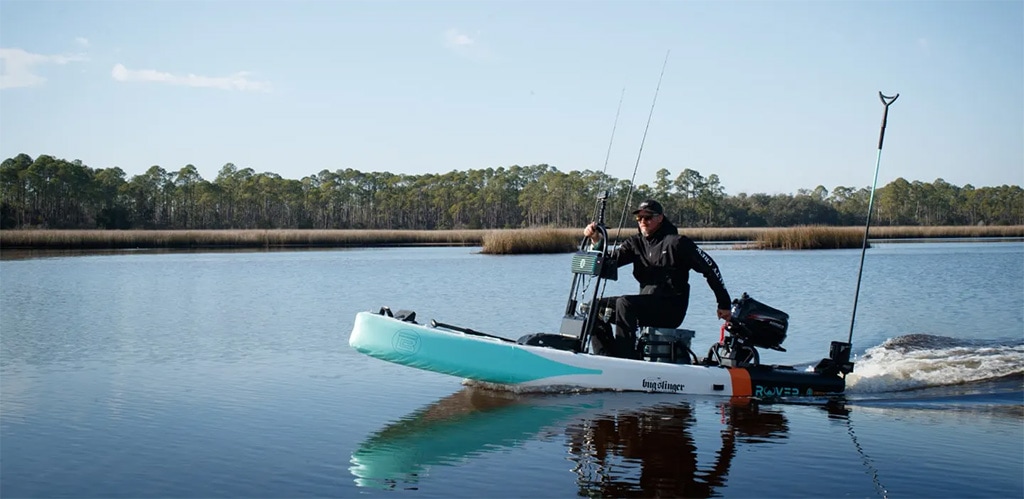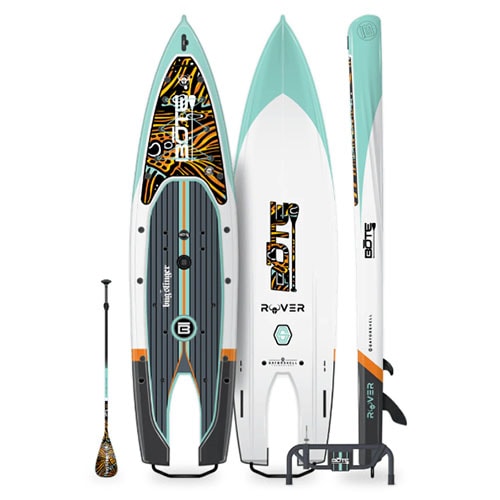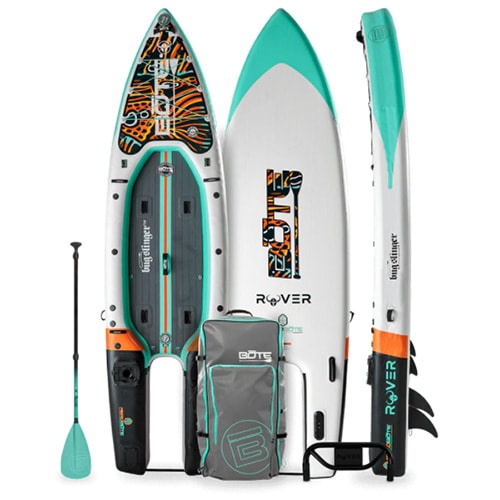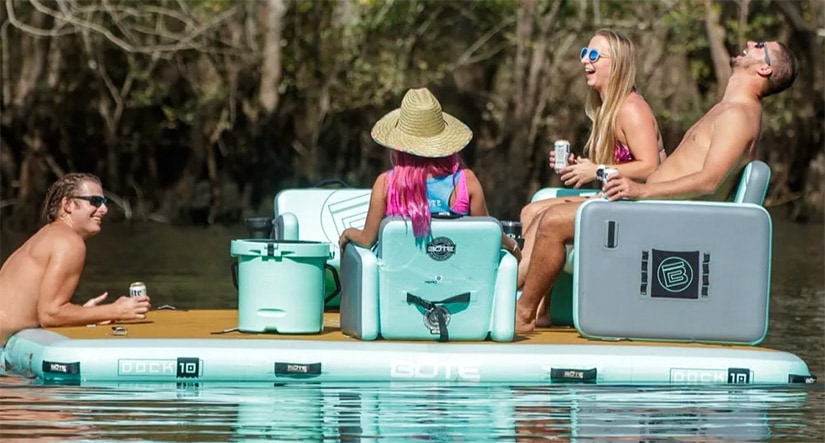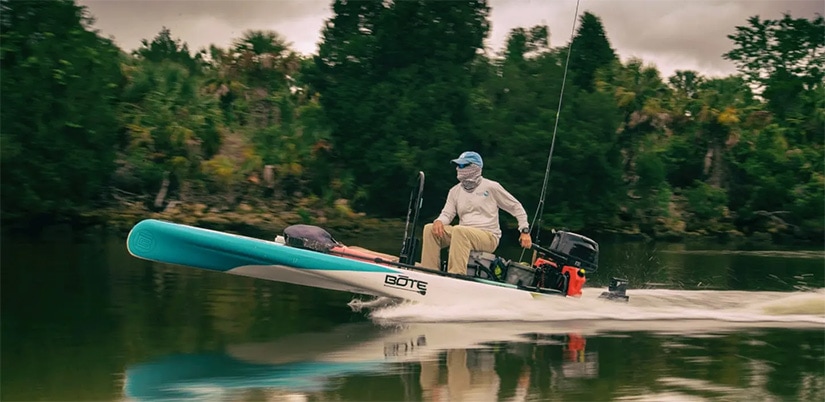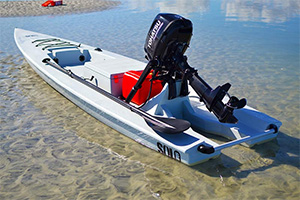Struggling to decide between a paddle board and a skiff for your fishing expeditions? Get the benefits of both watercraft with the BOTE Rover and BOTE Rover Aero.
The BOTE Rover is the lovechild of a SUP and a micro skiff. Attach a motor to power through deep water and get to your fishing spot in minutes. Then switch to a paddle and silently stalk your catch in the shallowest of waters.
The BOTE Rover and BOTE Rover Aero motorized paddle boards have similar features. The big difference is that the Rover is a solid board, whereas the Rover Aero is an inflatable fishing SUP.
Which is best for you? Read on to find out.
BOTE Rover vs. BOTE Rover Aero
| Pros |
|
| Cons |
|
| Pros |
|
| Cons |
|
Is the BOTE Rover Motorized Paddle Board for You?
The Rover is definitely a niche board. I’d recommend it for paddlers who want to fish or paddle some distance from their launch point. Not everyone has the time (or the energy!) to paddle for miles, particularly if you’re going against the current. The Rover lets you motor to your fishing spot, so you can reduce fatigue and make the most of your time on the water.
You can adapt some SUPs to take a small trolling motor, but the Rover is specifically designed for motoring—no DIY required!
If you’re short on storage space at home, I’d recommend the BOTE Rover Aero instead. It has many of the same features as the solid board but when deflated it’s small enough to transport in your trunk and store in your closet.
Neither board models are ideal for use solely as a SUP, as they’re much wider than your standard paddle board. This gives them the stability you want for a fishing platform, but it does mean they’re slower and harder to paddle long distances.
Key Features of the BOTE Rover
The Rover microskiff is a 14-foot board with a huge 500-pound capacity. Read on to find out what sets it apart from standard SUPs.
Motor-Compatible
The Rover has a deep cutout at the rear and comes with a Motorac attachment that slots into receivers on the rails. It’s really easy to fit the Motorac to the board. Simply slot it into the receivers and tighten using the supplied Allen key. There are also tie-down straps for extra security.
BOTE recommends using the Hidea HDF6 6-horsepower outboard motor with the Rover. If you want more power, you can also use a 9-horsepower motor (the Aero is only rated for a 6-horsepower motor). The BOTE Rover’s top speed is around 18 mph.
The Motorac comes with attachment points for you to add extra fuel or water. I really like this feature, as it keeps bulky containers off the deck and away from your feet.
Deep-V Nose for Efficient Paddling
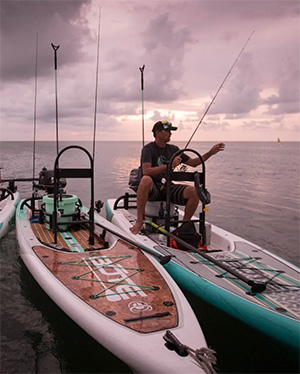
The displacement hull and deep-V keel at the bow help the board slice through the water efficiently. This means it takes less effort to keep the SUP moving in a straight line.
The Rover comes with a 10-inch center fin which helps with tracking in deep water and two smaller side fins.
The Rover is longer and slimmer than the Rover Aero, which means it’s faster in the water and easier to paddle.
When you use a motor to power the board, the nose lifts up and out of the water for a faster, smoother ride.
Exceptional Stability
BOTE states that the Rover is the most stable board they’ve developed—which is saying something! Both the Rover and the Rover Aero are significantly wider than standard SUPs (the Rover is 40-inches wide, the Aero 40.5-inches wide).
This extra width, plus thick, stable rails, makes the Rover a great fishing platform.
Modular Configuration
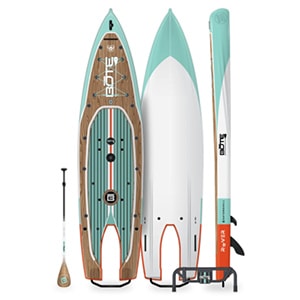
BOTE’s Rac system is modular. There are multiple Rac mounting points on the deck of the Rover, so you can adjust your setup quickly and easily to suit your needs and activity.
In my opinion, this is one of the best reasons to choose a BOTE board. If you’re handy with a drill, you can customize other hard skiffs, such as the Solo Skiff, but once your setup is in place, you’re stuck with it. It only takes seconds to change the setup on the Rover as the Racs simply slot in and pull out.
BOTE’s Bucket Rac is designed to hold a cooler or bait bucket. You can fit it just in front of the motor and use the cooler as a handy seat or slot it in at the front if you want to balance the load. It also pulls double-duty as a rod holder, so you don’t need to buy a separate rack.
As the Rover’s a paddle board hybrid, there isn’t a rail to cling onto when you’re traveling at high speeds. Fortunately, BOTE’s Grab Rac gives you something to hang onto whether you’re standing up or sitting down. It also has a pair of rod holders, MOLLE loops, and a foam hook caddy for your flies and lures.
I think the Bucket Rac and Grab Rac are the best mounts for the Rover, but you can also add the Tackle Rac, which is useful for keeping bags and other kit off the deck when you’re paddling.
On the underside of the Rover, there are holes to slot in BOTE’s Wheel Rac. This makes it easy to transport the Rover from your vehicle to the water.
Multiple Attachment Points to Customize Your Setup
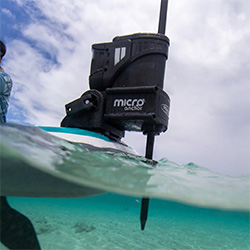
The Rover has more than a dozen plugs on its deck and rails to customize your fishing setup. You can switch these for a variety of mounts to attach accessories such as fish finders, rod holders, and cameras.
At the rear of both boards, there are mounting points for BOTE’s Power-Pole anchor system, which lets you anchor the board in shallow water (you’ll need to buy the Sandspear or another anchor pole to go with this). You can also attach a rope to the recessed grab handle on the bow to tie the board off to a dock or boat.
Quick and Easy Onboard Storage
The Rover’s adjustable bungee straps give quick and easy storage for drybags and extra gear at the bow.
One feature that the Rover has that the inflatable Rover Aero doesn’t, is built-in rod storage holes. Just slide your rod in and it’s neatly stored out of your way.
You also get BOTE’s Stashpod. This is a small compartment that’s perfectly sized for a drinks can. You can also use it to store small items, such as keys. Switch it for the MAGNEPOD lid to create a magnetic base for a compatible coffee cup or water bottle.
Integrated Paddle Sheath to Stow Your Paddle
Like BOTE’s other boards, the Rover comes with a slot in the bow which you can slip the blade of your paddle into. This integrated paddle sheath provides a quick, easy way to stash your paddle, but it does mean the paddle sticks up in the air, so it can get in the way if you’re moving around or trying to cast.
I prefer to store my paddle on top of the deck for longer periods. Fortunately, the Rover comes with three “vertebrae” (small rubber mounts) that screw into the plugs on the side of the board. These allow you to stash your paddle or a sandspear securely.
Tougher than Other Hard Boards
Solid paddle boards are more prone to damage than inflatable SUPs. The BOTE Rover Gatorshell is constructed from ABS plastic, which is strong and stands up well to physical impact. BOTE has combined this with ballistics-grade composites to create a material that’s six times tougher than the epoxy traditionally used in solid paddle boards.
You’ll still have to treat it with care, but the Rover should stand up to minor bumps and abrasions better than most solid SUPs.
Key Features of the BOTE Rover Aero
The BOTE Rover Aero is the Rover’s inflatable counterpart, and while it is similar, it does come with a few differences. The Rover Aero’s top speed is 16 mph, just a fraction slower than the Rover.
At 12.5 feet, it’s also shorter than the solid Rover board. As it’s an iSUP, it doesn’t have a displacement hull, which also makes it slower in the water. However, the Rover Aero does have some advantages over the Rover.
Compact and Easy to Transport
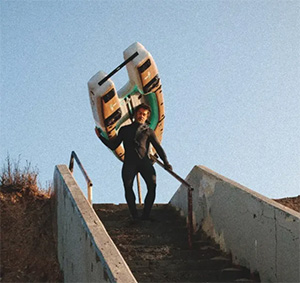
Not everyone has a garage or yard to store a skiff in. The BOTE Rover Aero packs down into a travel bag measuring just 45 x 13 x 21 inches. You can store it in your closet and toss it into the trunk of your car to drive to your launch point.
It’s pretty light too. Not as light as many iSUPs, but that’s because it’s wider than most SUPs. However, the Rover Aero weighs 63 pounds compared to the 105-pound weight of the Rover, so you’ll really notice the difference when carrying it to the water, particularly if you’re on your own.
You can even take it on vacation with you. The Rover Aero’s rolling travel bag makes it easy to transport and spot at baggage claim!
The only downside is that the Rover Aero isn’t compatible with BOTE’s Wheel Rac. That means you’ll want to inflate it as close to the water as possible.
Check Price of the Bote Rover Aero
More Robust than the BOTE Rover
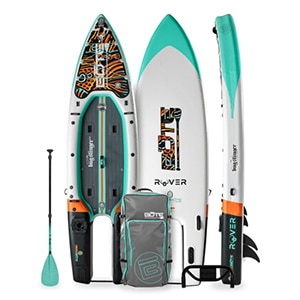
One of the downsides of hard paddle boards is that they’re more fragile than inflatables. This is true of any hard board, not just the Rover.
Is this an issue?
Well, it depends on how delicately you treat your kit and how comfortable you are making minor repairs. If you’re careful loading and unloading your board and you keep an eye out for any underwater rocks or hazards, then you may not run into any problems.
On the other hand, if you’re a little clumsy or you don’t want to have to fiddle around with epoxy resin, then the BOTE Rover Aero may be a better choice. It’ll bounce off rocks and other obstacles, and its PVC skin will stand up to the toughest tests. You could even run over it with a truck, as demonstrated in BOTE’s unique promotional video!
More Budget-Friendly
Neither the Rover nor the Rover Aero is what you could call a cheap paddle board. You get what you pay for when it comes to SUPs and I’ve raved many times about BOTE’s premium quality boards!
That said, the Rover Aero is around $2k cheaper than the Rover, so if cost is a consideration, you may want to plump for the inflatable board.
Rover Aero Configuration and Accessories

Similar to the Rover, you can sit down or stand up when driving the Rover Aero, as well as using it as a paddle board without the motor.
The Aero is compatible with both the Bucket Rac and the Grab Rac. However, as it’s an inflatable, the Racs slot into receivers that you screw onto the board, rather than into the board itself. The Rac receivers stick up above the deck, and you have to attach and detach them every time you inflate and deflate the board.
The Rover Aero has two Rac mounting points on the deck, however it only comes with one pair of Rac receivers. That means you’ll need to buy a second pair of receivers if you want to use multiple Racs. There’s also a pair of D-rings, which you can use to tie down a cooler in the center of the deck.
I like that BOTE gives you a grab strap, which you can cling to when driving the board. It’s a shame you don’t get this with the solid Rover! The grab strap works great when you’re sitting down, but I’d opt for the Grab Rac if you’re standing as it offers more stability.
You also get a travel bag, repair kit, and hand pump with the Rover Aero.
Storage and Attachment Points
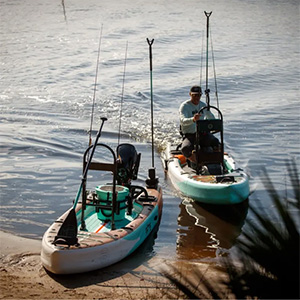
Due to the different construction type, the storage options are slightly different to the solid Rover. You get a good number of plugs that you can use to mount accessories, plus a couple of D-rings to attach the grab strap or other items.
Instead of a slot for your paddle, you get a plastic sheath that slots into attachment points at the bow. Personally, I prefer securing my paddle using the sandspear lash points on the rails (which you don’t get on the Rover).
One thing you get on the Rover Aero that you don’t on the Rover is a Sandspear sheath. This attaches to the side of the board and allows you to anchor the Aero using the Sandspear. It’s a cheaper alternative to the Power-Pole Micro anchor system.
Both models have adjustable bungee straps, but as the Rover is slightly longer, you get a bit more space for storing gear. You don’t get the Stashpod with the Rover Aero, so you’ll have to find somewhere else to store your keys. As you might expect, there aren’t any built-in rod storage holes.
Features and Accessories Compared
Here’s a quick comparison of what you get with the Rover and the Rover Aero.
| Feature | BOTE Rover | BOTE Rover Aero |
|---|---|---|
| Grab handles | Recessed grab handle on bow | Fabric handle on the bow and in the center of the deck |
| Paddle storage | Integrated paddle sheath, vertebrae on rails | Detachable paddle sheath, hook-and-loop straps on rails |
| Anchor options | Power-Pole Micro Anchor, grab handle on bow | Power-Pole Micro Anchor, Sandspear, grab handle on bow |
| General storage | Bungee cord, stashpod, rod storage holes | Bungee cord |
| Rac compatibility | Bucket Rac, Grab Rac, Tackle Rac, Wheel Rac | Bucket Rac, Grab Rac, Tackle Rac |
| Fins | 2 x side fins (removable), 1 x long fin (removable) | 2 x side fins (fixed), 1 x long fin (removable) |
| Compare Price of the Bote Rover | Compare Price of the Bote Rover Aero |
What People Are Saying About the BOTE Rover
The BOTE Rover and BOTE Rover Aero have many fans. As Mindgame607 says in this Reddit thread, BOTE boards are pricey but “the higher price tag = better materials = more rigid = more stability”.
Other users agree, as in this comment from a thread on the Rover Aero:
The author of the thread specifically bought the Aero model for its small pack size and weight:
As I mentioned above, solid paddle boards can be prone to damage, and some users agree with me, though others state that this is something to be expected and you just need to learn how to repair them! If that’s a deal-breaker for you, then go for the inflatable model.
Check Price of the Bote Rover (Aero)
BOTE Rover vs Solo Skiff
The Solo Skiff is another popular hybrid craft. Whereas the BOTE Rover is a hybrid between a SUP and a microskiff, the Solo Skiff shares more similarities with a sit-on-top kayak.
It’s a one-piece rotational-molded boat, constructed from high-density polyethylene. That makes it durable but heavy. The Solo Skiff weighs 150 pounds, compared to the Rover’s 105 pounds—definitely something you need to consider if you’re loading it onto a vehicle. The weight also makes it harder to paddle, especially in strong winds.
At first glance, the Skiff looks overly simple. That’s because you’re supposed to customize it yourself. This might be a pro or a con, depending on how specific your requirements are and how much time you want to spend in your garage.
The Solo Skiff has a nice built-in storage box that doubles as a seat, plus a built-in cooler area in the bow that can double as a dry storage area. The Rover has options for more storage, but they cost extra.
On that note, the Skiff is a lot cheaper than the BOTE Rover. If you’re on a budget, the Solo Skiff may be a more attractive option, but if money is no object, my vote goes to the Rover.
Conclusion
The BOTE Rover and Rover Aero are both great options to expand your fishing territory. If budget and transportation aren’t an issue, then the Rover performs better in the water. However, if you have limited storage or want a board you can take on vacation, you may prefer the flexibility of the Rover Aero.
Whichever you choose, a motorized paddle board gives you the freedom to explore new waterways and follow the fish wherever they go.

